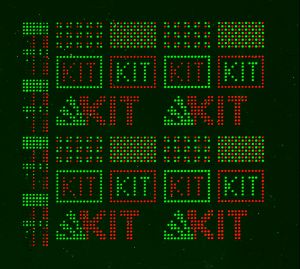Thanks to a new process from KIT, it is now possible to systematically test a large number of chemical reactions in a very small space and within a short time. It enables freely selectable molecules embedded in solid materials to react with each other in a nanometer-sized space. Since the chemicals used can now be dosed very accurately, it allows for efficient and material-saving searches for synthesis methods, which the scientists involved are now presenting in the Nature Communications journal. DOI 10.1038/NCOMMS11844
“All chemical syntheses require component A to be mixed with component B in solvent X so they can react with each other; that takes a lot of time and effort,” Frank Breitling, research group leader at the KIT Institute of Microstructure Technology, explains. Before a new synthesis method is found, a lot of different types of chemical components, catalysts, solvents, and activators need to be tried out using different mixing ratios. Often it only turns out at a very late stage of the synthesis process that the reaction method used won't be successful and expensive chemicals have been wasted.
“We are miniaturizing this process so that we don't have to take it step by step in the traditional and time-consuming way, but can trigger many reactions at the same time in a very small space,” says Alexander Nesterov-Müller, who also carries out research at the Institute of Microstructure Technology and who teaches at the Department of Mechanical Engineering as an associate professor. All molecules that can be coupled to a carrier are suitable for this.
Physicist Nesterov-Müller and biochemist Breitling have designed a machine in their work groups which can be used to automatically stack nanometer-thin layers of various solid materials including embedded reaction molecules on top of and next to each other. Tiny areas called spots, the size of which can be precisely defined, are punched out of a thousandth of a millimeter thin reusable layer of material with the help of a laser and are moved to a synthesis slide. By adding heat or solvents, these layers of material become fluid so that the chemical components contained in them get mixed and react with each other – just like in a traditional synthesis process.
The scientists have examined the cLIFT (combinatorial Laser-Induced Forward Transfer) process using the synthesis of peptides – short amino acid chains – as an example. Thanks to the high density of the areas of examination called peptide arrays and the high number of potential combinations of different amino acid components in a very small space, a large number of chemical reactions can be systematically tested within a short time. Currently, the machine achieves 50,000 of these stacked-up material spots per glass slide, which corresponds to 5,000 per square centimeter.
One aim of the new technology could be to read out the immune system, and detect antibodies in the human blood serum more easily and quickly to identify altered amino acids in rheumatism patients. Malaria research and the treatment of multiple sclerosis could also benefit from this method. “Our process is primarily a research tool,” says Breitling. It is also interesting for pharmaceutical companies, for example to find new antigens for developing vaccines. Another vision of the future is to build databases which provide information to researchers on synthesis methods that have already been successful.
In interdisciplinary cooperation with Stefan Bräse's work group at the KIT Institute of Organic Chemistry, the scientists want to extend the process to as many types of chemical synthesis as possible. To make the machine fit for commercial use, it needs to become even faster and more user-friendly, and also needs to be further miniaturized.
The new cLIFT process is one of the results of an ERC grant from the European Research Council (ERC), in which Alexander Nesterov-Müller developed interdisciplinary methods of combinatorial synthesis in array form.
Felix F. Loeffler, et al., High-flexibility combinatorial peptide synthesis with laser-based transfer of monomers in solid matrix material; Nature Communications, DOI: 10.1038/NCOMMS11844
Being “The University in the Helmholtz Association”, KIT creates and imparts knowledge for the society and the environment. It is the objective to make significant contributions to the global challenges in the fields of energy, mobility, and information. For this, about 10,000 employees cooperate in a broad range of disciplines in natural sciences, engineering sciences, economics, and the humanities and social sciences. KIT prepares its 22,800 students for responsible tasks in society, industry, and science by offering research-based study programs. Innovation efforts at KIT build a bridge between important scientific findings and their application for the benefit of society, economic prosperity, and the preservation of our natural basis of life. KIT is one of the German universities of excellence.

